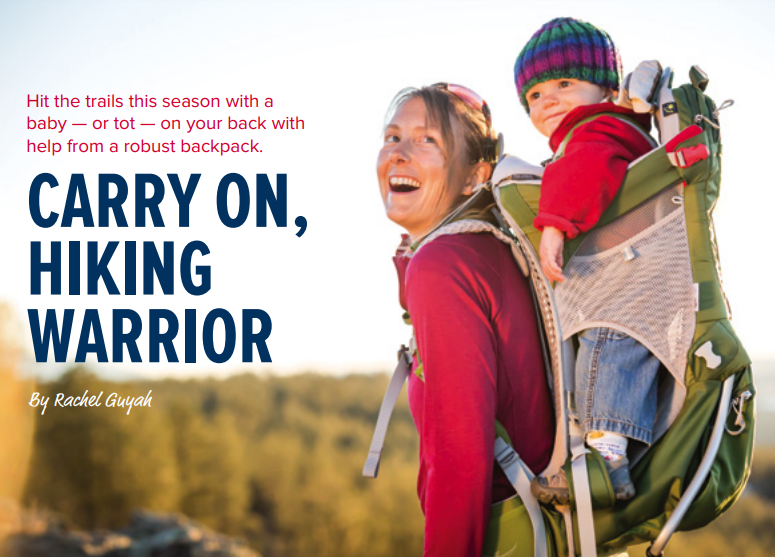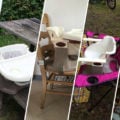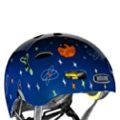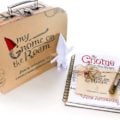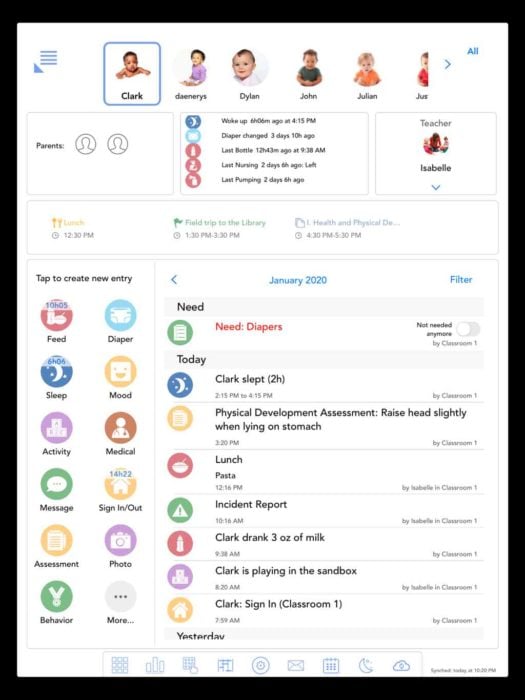Hit the trails this season with a baby — or tot — on your back with help from a robust backpack.
What exactly is a baby-carrying backpack?
Well, it’s basically a framed hiking backpack with a built-in area — called the “cockpit” — to hold your baby or toddler.
Backpack carriers are a great way for the whole family to experience adventures together — both on hiking trails in the woods as well as around town (at the zoo, farmer’s market or even on paved trails around the lakes).
Backpack carriers are:
Ergonomically friendly: Padded, adjustable shoulder straps and a hip belt help alleviate shoulder/back strain by redistributing your child’s weight to your hips and pelvic area. Unlike baby-wearing slings and other popular infant carriers, the hiking backpack includes a sort of suspension system, made up of several adjustable features, including a back panel, shoulder straps, load lifters, a hip belt, stabilizer straps and a sternum strap.
Sensory-rich seating: Perched upon your back, your kid enjoys a 360-degree view and high vantage point from which to soak in all the surrounding sights, sounds and smells.
Extended baby-wearing: Many backpack carriers are built to support up to 40 pounds (sometimes more), meaning you can comfortably enjoy the benefits of baby-wearing well into toddlerhood (provided you don’t mind bearing the increasingly heavy load).
Terrain versatility: Backpack carriers can often go where strollers (and newly walking toddlers) can’t, including up stairs, down steep slopes and over puddles and rocks.
Breaking down the features
Just like strollers and car seats, backpack carriers come in a variety of styles. Here’s a breakdown of the standard and optional features commonly found on backpack carriers.
Grab Handles – Most backpack carriers have two (one in front, one in back) for you to easily pick up and set down the carrier.
Cockpit – This is the area where your child sits. Look for soft padding, adjustable height settings and a wide seat for leg/hip comfort.
Harness –Backpack carriers come with a safety harness to secure your child in place. Harness types vary from butterfly chest buckles to five-point contraptions.
Shoulder Straps – These should be padded and adjustable for maximum parent comfort. Some models include a sternum/chest strap to help straps stay in the proper position.
Hip Belt – Ideally wide, thick and padded, this adjustable belt buckles around your hips to distribute the weight of your child to your hips and pelvic area — instead of your shoulders and lower back.
Storage – The number (and volume) of storage compartments varies widely across models. Mesh pockets offer flexibility and easy access, while zippered compartments keep important items safe.
Kickstand – Made of metal or aluminum, the kickstand is a stabilizing bar that can be kicked or locked out, allowing the backpack to sit upright on the ground while you’re loading/unloading your kiddo.
Sun/Rain Hood – Some backpack carriers come with a built-in shade or hood that can be deployed to protect your little one from the elements, while other models offer them as a separate add-on purchase (or not at all).
Three options to explore
There are a lot of kid-carrying packs out there, but the brand and model you ultimately decide on will be based on your budget, comfort and fit for you and your child and your intended purpose or activity — quick urban errands versus long wilderness hikes, for example.
These backpack carriers are well rated and popular with parents.
All three are geared toward babies with enough neck strength to safely and steadily hold their heads up on their own.
Typically, this milestone is achieved around 6 months old, but check with your pediatrician if you’re unsure.
Max weight: 48 pounds (40 pounds total, including child, backpack and cargo)
Overview: This lightweight, low-cost backpack is ideal for errands and shorter hikes.
Sort of Budget-friendly: At under $300, it’s one of the more affordable options out there, yet it still offers ample storage and comfort.
Lightweight and compact: Several pounds lighter than the other two models featured, this petite pack is easier to store and transport. It also might be more comfortable for shorter parents.
Safety harness: Like the Deuter, this model features a five-point safety harness.
Max weight: 40 pounds (48.5 pounds total, including child, backpack and cargo)
Five-point harness: While some backpack carriers feature only a chest clip, this model employs a five-point harness, offering added security on rugged terrain.
Side-entry buckle: Ideal for independent, “let-me-do-it” toddlers, this model includes a side buckle you can release to let your child climb into the seated area on his own.
Downsides: There’s no built-in sunshade on this model. It can be bought separately, but it’s a bit cumbersome to set up and take down. Also this pack’s deep, roomy cockpit is a bit looser than other brands, which works well for toddlers, but might concern parents with younger babies. That said, the five-point harness provides added security.
Osprey Poco Plus
Max weight: 40 pounds (48.5 pounds total, including child, backpack and cargo)
Built-in sunshade: The top portion of this pack includes a zippered compartment for the collapsible sunshade, making it fast and easy to deploy or put away on the fly.
Highly adjustable: This pack’s 6 inches of torso adjustment can help parents customize its fit, which is an especially big benefit if two different-sized parents plan to use the backpack.
Supportive foot stirrups: These are ideal for toddlers because they help improve blood flow/circulation and also reduce stress placed on you child’s feet/legs (from prolonged sitting). Bonus: Your kiddo can play “Giddy up!” while you’re on the trail.
Downsides: At over $400, this backpack carrier is an investment. That said, the quality, comfort and thoughtful features may be worth the splurge.
Where to buy-
REI / Scheels / Dick’s Sporting Goods / Midwest Mountaineering, Minneapolis / Trailfitters, Duluth
It’s best to shop for backpacks in person — with your kid. That way, you can try them on and work with a professional at the store on adjustments for a good fit for both you and your child. Outdoor store employees can also show you how to safely lift up and set down the backpack while your child is in it.
Minnesota Parent may earn a small commission for any affiliate links to any products or services from this website.
Hike along a trail at the Richardson Nature Center in Bloomington.





